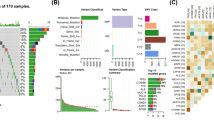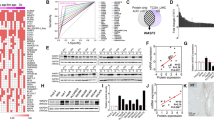Abstract
Background
Hepatocellular carcinoma (HCC) is the most common primary liver malignancy with a high mortality rate. P14.5 is a member of the highly conserved YER057c/YIL051c/YjgF subfamily and is highly expressed in the liver. However, its low expression is associated with carcinogenesis in HCC.
Objective
This study aimed to investigate the role and prognostic significance of P14.5 in HCC.
Methods
The clinical significance of P14.5 in HCC was examined using ONCOMINE, UALCAN, Human Protein Atlas, and Kaplan–Meier plotter. The DNA methylation profile of the P14.5 promoter was examined in 103 HCC and paired precancerous tissues; the HCC cell lines HepG2, MHCC-97L, SMMC-7721, SK-Hep-1, and Huh7; and the normal hepatic cell line HL-7702 via MALDI-TOF mass spectrometry. In addition, in vitro experiments were performed to examine the effects of P14.5 overexpression on the proliferation and migration of SMMC-7721 cells.
Results
Low expression of P14.5 was correlated with shorter overall survival (OS) and disease-free survival (DFS) in HCC. Based on the results of MALDI-TOF mass spectrometry, no difference was observed in the methylation level between HCC cells and normal human hepatic cells and between HCC and paired precancerous tissues. Additionally, P14.5 overexpression promoted the proliferation and inhibited the migration of SMMC7721 cells in vitro.
Conclusions
P14.5 may serve as a prognostic biomarker in HCC and plays a role in the migration and proliferation of HCC cells. Low expression of P14.5 during hepatocarcinogenesis is not attributed to DNA methylation.



Similar content being viewed by others
References
Alam A, Levanduski E, Denz P, Villavicencio HS, Bhatta M, Alhorebi L, Zhang Y, Gomez EC, Morreale B, Senchanthisai S et al (2022) Fungal mycobiome drives IL-33 secretion and type 2 immunity in pancreatic cancer. Cancer Cell 40(153–167):e111
Ceciliani F, Faotto L, Negri A, Colombo I, Berra B, Bartorelli A, Ronchi S (1996) The primary structure of UK 114 tumor antigen. FEBS Lett 393:147–150
Chen PF, Wang F, Feng JR, Zhou R, Chang Y, Liu J, Zhao Q (2017) Co-expression network analysis identified six hub genes in association with metastasis risk and prognosis in hepatocellular carcinoma. Oncotarget 8:48948–48958
Chong CL, Huang SF, Hu CP, Chen YL, Chou HY, Chau GY, Shew JY, Tsai YL, Chen CT, Chang C et al (2008) Decreased expression of UK114 is related to the differentiation status of human hepatocellular carcinoma. Cancer Epidemiol Biomarkers Prev 17:535–542
Djinovic Carugo K, Saraste M, Oka T (1999) Crystallization and preliminary X-ray diffraction studies of perchloric acid soluble protein (PSP) from rat liver. Acta Crystallogr D 55:667–668
Gyoeri GP, Pereyra D, Braunwarth E, Ammann M, Jonas P, Offensperger F, Klinglmueller F, Baumgartner R, Holzer S, Gnant M et al (2019) The 3–60 criteria challenge established predictors of postoperative mortality and enable timely therapeutic intervention after liver resection. Hepatobil Surg Nutr 8:111–124
Heyn H, Esteller M (2012) DNA methylation profiling in the clinic: applications and challenges. Nat Rev Genet 13:679–692
Kanouchi H, Oka T, Asagi K, Tachibana H, Yamada K (2000) Expression and cellular distribution of perchloric acid-soluble protein is dependent on the cell-proliferating states of NRK-52E cells. Cell Mol Life Sci 57:1103–1108
Kanouchi H, Tachibana H, Oka T, Yamada K (2001) Recombinant expression of perchloric acid-soluble protein reduces cell proliferation. Cell Mol Life Sci 58:1340–1343
Kuan T, Xuan Z, Xiaoli M, Bingren H, Hong C, Deng C (2014) Construction of a lentiviral vector carrying hrsp12 gene and its effect on hela cell apoptosis and proliferation. Zhongguo Shi Yan Xue Ye Xue Za Zhi 43:63–67
Lee HJ, Su Y, Yin PH, Lee HC, Chi CW (2009) PPAR(gamma)/PGC-1(alpha) pathway in E-cadherin expression and motility of HepG2 cells. Anticancer Res 29(12):5057–5063
Liu CY, Chen KF, Chen PJ (2015) Treatment of liver cancer. Cold Spring Harb Perspect Biol 5:a021535
McPherson S, McMullin MF, Mills K (2017) Epigenetics in Myeloproliferative Neoplasms. J Cell Mol Med 21:1660–1667
Morishita R, Kawagoshi A, Sawasaki T, Madin K, Ogasawara T, Oka T, Endo Y (1999) Ribonuclease activity of rat liver perchloric acid-soluble protein, a potent inhibitor of protein synthesis. J Biol Chem 274:20688–20692
Oka T, Tsuji H, Noda C, Sakai K, Hong YM, Suzuki I, Munoz S, Natori Y (1995) Isolation and characterization of a novel perchloric acid-soluble protein inhibiting cell-free protein synthesis. J Biol Chem 270:30060–30067
Pinero F, Dirchwolf M, Pessoa MG (2020) Biomarkers in hepatocellular carcinoma: diagnosis. Progn Treat Res Assess Cells 9:1370
Pozdniakovaite N, Popendikyte V (2005) DNA methylation differences in human p14.5 gene promoter region in normal and proliferating cells. Dev Growth Differ 47:493–499
Samuel SJ, Tzung SP, Cohen SA (1997) Hrp12, a novel heat-responsive, tissue-specific, phosphorylated protein isolated from mouse liver. Hepatology 25:1213–1222
Schmiedeknecht G, Kerkhoff C, Orso E, Stohr J, Aslanidis C, Nagy GM, Knuechel R, Schmitz G (1996) Isolation and characterization of a 14.5-kDa trichloroacetic-acid-soluble translational inhibitor protein from human monocytes that is upregulated upon cellular differentiation. Eur J Inorg Chem 242:339–351
Siegel RL, Miller KD, Jemal A (2019) Cancer statistics. CA Cancer J Clin 69:7–34
Stenner-Liewen F, Luo G, Sahin U, Tureci O, Koslovski M, Kautz I, Liewen H, Pfreundschuh M (2000) Definition of tumor-associated antigens in hepatocellular carcinoma. Cancer Epidemiol Biomarkers Prev 9:285–290
Wang J, Cao X, Zhang Y, Su B (2012) Genome-wide DNA methylation analyses in the brain reveal four differentially methylated regions between humans and non-human primates. BMC Evol Biol 12:144
Funding
This work was supported by Natural Science Foundation of Guangxi (No. 2018GXNSFAA138144, No. 2017GXNSFAA198079, and No. 2020GXNSFBA297150). We appreciated Dr Yu Sun for kind help in bioinformatic analysis.
Author information
Authors and Affiliations
Corresponding author
Ethics declarations
Conflict of interest
Author Sa Song, Jian Pan, Yaoyao Zhang, Yuehuan Xu, Qingmei Zhang, Xiaoxun Xie, Qingniao Zhou, Farong Mo, Guorong Luo, and author Naixia Chao declare that they have no conflict of interest.
Ethical approval
This study was approved by the Ethics Committee of the First Affiliated Hospital of Guangxi Medical University (Nanning, China) (No. 20210167). No competing financial interests exist.
Additional information
Publisher's Note
Springer Nature remains neutral with regard to jurisdictional claims in published maps and institutional affiliations.
Supplementary Information
Below is the link to the electronic supplementary material.
Rights and permissions
Springer Nature or its licensor (e.g. a society or other partner) holds exclusive rights to this article under a publishing agreement with the author(s) or other rightsholder(s); author self-archiving of the accepted manuscript version of this article is solely governed by the terms of such publishing agreement and applicable law.
About this article
Cite this article
Song, S., Pan, J., Zhang, Y. et al. P14.5 functions to inhibit cell migration and can be used as a prognostic marker in hepatocellular carcinoma. Genes Genom 45, 83–91 (2023). https://doi.org/10.1007/s13258-022-01331-z
Received:
Accepted:
Published:
Issue Date:
DOI: https://doi.org/10.1007/s13258-022-01331-z




